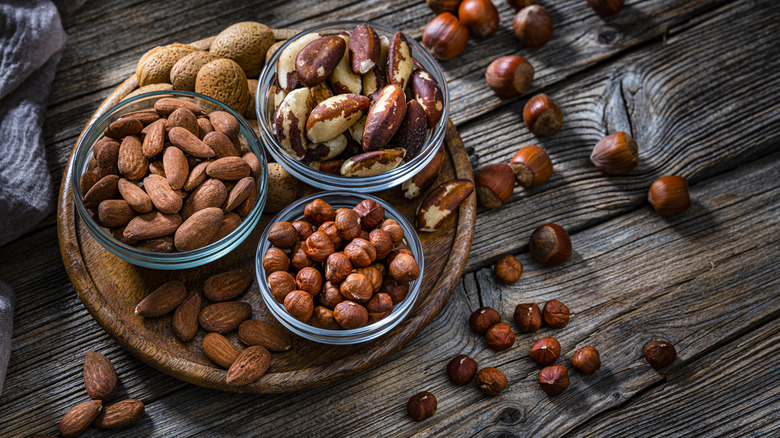Follow This Golden Rule When Roasting Nuts
If you're looking to boost a dish, roasted nuts could help take it to the next level. With a fantastically low effort-to-deliciousness ratio, roasted nuts add aroma, flavor, and texture that can work well in sweet or savory dishes. Think of the toasted pine nuts in your penne pesto, browned cashews in a delicate savory pilaf, or slivers of crunchy almond on a creamy dessert.
Getting your nut-roasting game on point can help you always have these recipe boosters on hand, and once they're done, roasted nuts will retain their crunch and toasty flavor for at least three days in an airtight container. Just make sure you're not using nuts that have gone bad before giving them a toast.
If they're for a savory dish, it's best to salt the nuts before you begin roasting so the seasoning better adheres to the released oils. It's also a good idea to roast whole nuts, and chop them afterward if your recipe calls for that; chopping nuts up pre-roast can lead to uneven cooking. Once they've reached their toasty peak, quickly transfer them to a plate or bowl, so they stop cooking and finish crisping up. With these tips in mind, let's get to the actual roasting.
The golden rule for perfectly roasted nuts is low and slow heat
The most important thing to keep in mind when roasting nuts is to apply gentle, even heat to let them cook through without the outsides getting burnt. No matter the method, nuts should be spread in a single layer and shuffled occasionally to ensure even cooking. As a rule of thumb, limit the temperature to 350 degrees Fahrenheit when roasting to ensure the outer layers of the nuts don't toast too quickly. If you're using a convection oven, reduce that amount by about 25 degrees.
Different nuts also have different roasting thresholds. Tender ones like pine, pecans, pistachios, and walnuts will take between 5 and 10 minutes to roast in the oven, while hardier varieties like almonds, macadamias, and hazelnuts can take 10 or more minutes. Since most ovens have uneven heating, remove the tray in between roasting and give the nuts a good shake to help with even cooking. There is also a fine line between perfectly roasted and slightly burnt, so the closer they get to being done, the more regularly you should check on them.
And finally, remember that the best tool to alert you when the nuts are roasted is your nose. The aroma is light and toasty, without hints of sharp or acrid burnt smells. Another way to check is to split the roasted nut to ensure the insides are browned.
Roasting nuts: oven, skillet, or microwave?
While the oven is generally the go-to method for roasting nuts, it may not always be the best option, especially when you account for the added time of preheating. It makes sense for large batches, but for a quick small one, a skillet is faster and more practical, though you'll need to give them more of your attention.
For even heating and to avoid burning, nuts being roasted in a skillet must be tossed often — almost constantly. The process is much faster than in the oven but requires you to be present throughout the process. Generally, softer nuts like pine and pistachios that are easier to cook through are more suitable for skillet roasting, which should always be done on medium to low heat.
The surprise contender here is actually the microwave, but if used correctly, it offers the best balance of speed and convenience for roasting nuts. You still need to place the nuts in a single layer on a plate to roast them, so large batches may not be possible, but doing multiple batches is but the work of a moment.
Begin by microwaving on high for about a minute, then pause and toss to mix the nuts before repeating. Follow this process until they become fragrant — which can take 3 to 8 minutes, depending on the nut. And add a splash of neutral oil before roasting nuts in the microwave for better browning.


